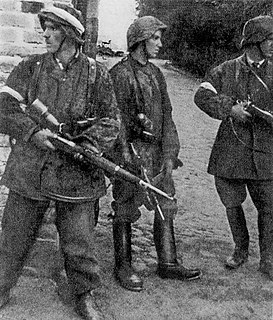 W
WCisie pronounced [ˈt͡ɕiɕe] is a village in the administrative district of Gmina Halinów, within Mińsk County, Masovian Voivodeship, in east-central Poland.
 W
WGerman retribution against Poles who helped Jews were repressive measures taken by the German occupation authorities against non-Jewish Polish citizens who helped Jews persecuted by Nazi Germany during the Holocaust in Poland, 1939 to 1945.
 W
WAction Ghetto - code name for the armed actions of the Polish Underground State during the Warsaw Ghetto Uprising aimed at helping the insurgents. The name was given to a series of combat actions carried out by the Home Army during the uprising between 19 April 1943 and May 16, 1943.
 W
WJanusz Korczak Monument in Warsaw at Świętokrzyski Park has been unveiled in 2006. It is dedicated to the memory of Janusz Korczak. It has been designed by Jan Bohdan Chmielewski and Zbigniew Mikielewicz.
 W
WThe Markowa Ulma-Family Museum of Poles Who Saved Jews in World War II is a museum located in Markowa, Poland. The Łańcut Castle Museum began the Ulma-Family Museum's construction in 2013, and the new Museum opened on 17 March 2016.
 W
WThe Provisional Committee to Aid Jews was founded on September 27, 1942, by Zofia Kossak-Szczucka and Wanda Krahelska-Filipowicz. The founding body consisted of Polish democratic Catholic activists associated with the Front Odrodzenia Polski, Polska Organizacja Demokratyczna, Związek Syndykalistów Polskich and PPS-WRN. The codename for the organization was "Konrad Żegota Comittee" and the same codename was retained for the direct successor, the underground Council to Aid Jews.
 W
WPolish Jews were the primary victims of the German-organized Holocaust in Poland. Throughout the German occupation of Poland, many Poles rescued Jews from the Holocaust, in the process risking their lives – and the lives of their families. Poles were, by nationality, the most numerous persons who rescued Jews during the Holocaust. To date, 7,112 ethnic Poles have been recognized by the State of Israel as Righteous among the Nations – more, by far, than the citizens of any other country.
 W
WŻegota was the Polish Council to Aid Jews with the Government Delegation for Poland, an underground Polish resistance organization, and part of the Polish Underground State, active 1942–45 in German-occupied Poland. Żegota was the successor institution to the Provisional Committee to Aid Jews and was established specifically to save Jews. Poland was the only country in German-occupied Europe where such a government-established and -supported underground organization existed.
 W
WThe Żegota Monument is a stone monument dedicated to the Żegota organization, which rescued Jews during the Holocaust in Poland. It is on Anielewicza Street in Warsaw in the Muranów neighborhood of Warsaw, Poland, near the Monument to the Ghetto Heroes and the POLIN Museum of the History of Polish Jews.